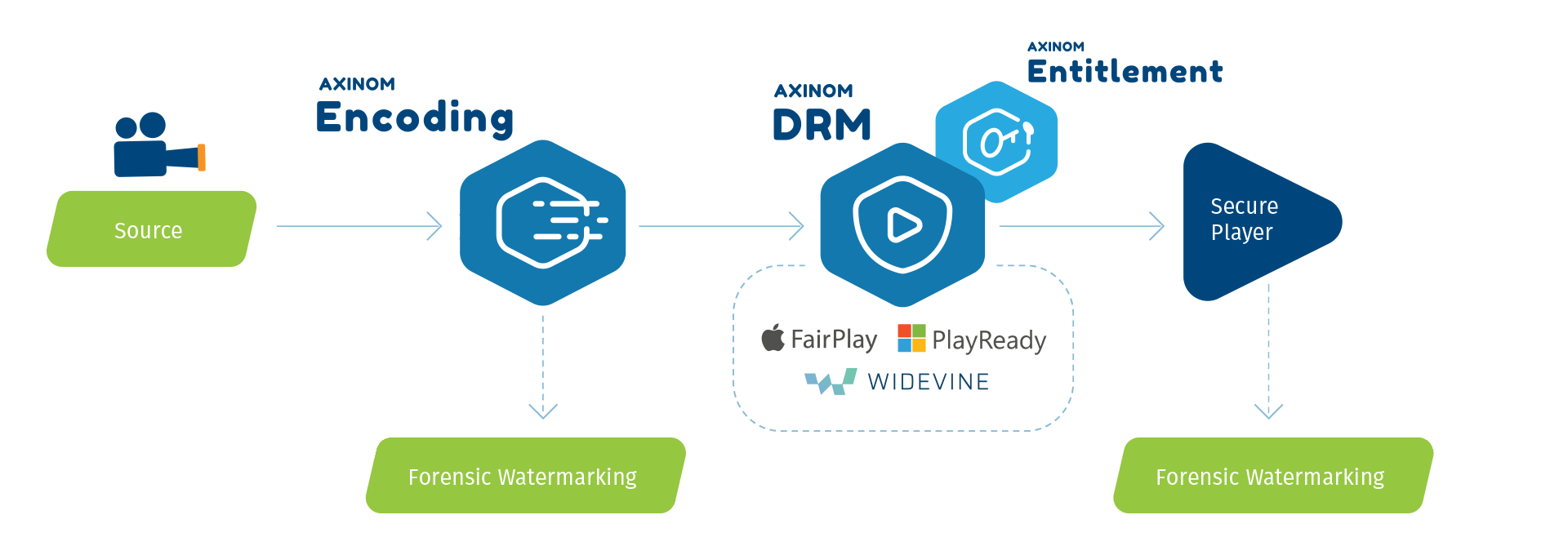

How Forensic Watermarking and Multi-DRM Secure Video Content
Forensic watermarking stops piracy and protects content. But how it complements a multi-DRM to secure video in a multi-screen world? Find the answer below.
According to the MPAA, pirated video generates upwards of 230 billion views yearly, with 80% of global online piracy taking place through illegal streaming services. Forensic watermarking, used in combination with a multi-DRM, can help content platforms to protect their media on all kinds of smart devices.
With the enhanced viewer experience that streaming services offer these days, consumers can stream content across multiple devices, from smart TVs to gaming consoles, mobile phones, and PCs. This fragmentation of content delivery also created loopholes for video piracy and has made video watermarking a necessity. Although a multi-DRM solution can indeed secure content on multiple devices and platforms, it is essential to complement it with video watermarking software to create a secure system that helps to deter the distribution of unauthorized copies.
How Multi-DRM Protects Video in a Multi-Screen World
DRM is a content protection technology that secures and controls access to video content in two ways. One is by encrypting content so that only authorized viewers can decrypt it. The second is by enforcing a list of entitlement policies that eligible viewers must adhere to. Different smart devices and content platforms support a variety of DRMs, with the top services being Microsoft PlayReady, Apple FairPlay, and Google Widevine. Since video content needs to be protected with the right technology for every smart device, TV, and browser, multi-DRM has become the ideal solution to guarantee device and DRM compatibility.
Multi-DRM and traditional DRM services fulfill the same tasks: 1. Encryption: The encryption of video content happens at the content processing stage. An encoder/packager requests an encryption key from the DRM service. The encoder goes on to encrypt and re-package the content with the keys it receives. 2. Decryption: When the encrypted video needs to be played, the player sends out a license request to the DRM service. The player uses the license key it receives to decrypt the content to initiate playback. 3. Entitlement rules enforcement: An entitlement service within the DRM regulates video content viewing by verifying users, locations, and time of access. Some of the typical aspects that a DRM entitlement service regulates are: * Geo-blocking: This is either allowing or disallowing determined countries from accessing certain content. * Premium content protection: This protects higher quality content, such as 4K/UHD video, from being on unauthorized screens or devices that do not comply with the hardware-level set by the DRM. * Download controls: To manage which video content can be downloaded. * Time controls: Which include the release and expiration dates of content.
How Watermarking Stops Video Piracy
Once a user is identified and the content starts playing, the media can still be exposed to piracy threats such as screen recording. Digital watermarking is a technology that marks video content to track leaked copies and piracy sources. By watermarking their content, platforms can demand illegal copies to be taken down or start legal action against unauthorized distributors.
There are two types of watermarking, visible and forensic watermarking. As the name suggests, the former is noticeable to the end user, whereas the latter is not. By being invisible, forensic watermarking provides a better viewing experience and is a lot harder for pirates to remove. Modern watermarking solutions integrate seamlessly with many encoding and DRM providers and can protect both live and video-on-demand content. A powerful tool against piracy, forensic watermarking has become a mandatory requirement for distributing higher quality content (such as 4K/UHD video) or content with high demand (like live sports).
Implementing Forensic Watermarking
There are two ways in which content platforms can integrate forensic watermarking into their systems:
-
Server-side watermarking - In this process, the watermarking is applied at the encoding and packaging stage of the content supply chain. Usually, two data sets of a video stream are created and then the media segments are distributed in distinct patterns to viewers. If a video stream is pirated, the pattern of the video segments can be used to identify the source of the leakage. This is considered a safer approach as it doesn’t expose unprotected content on multiple devices. It also does not require complex and custom integration, making it ideal for multi-screen distribution such as OTT.
-
Client-side watermarking - In this process, watermarking is embedded on the client-side device (such as a set-top box, mobile device, smart TV, etc.) by compositing an image overlay onto the video stream. This approach is often applied during playback through code or third-party libraries that are integrated into the player. Client-side watermarking allows distributors to track their content at the device level and is widely used on live sports streams as it minimizes playback delay and detection time.
Achieving End-to-End Content Protection
By combining a multi-DRM with forensic watermarking, content platforms can ensure end-to-end protection of your video content across platforms and devices. While the DRM service focuses on regulating the access of only authorized users to the content, forensic watermarking tracks those users who illegally distribute the media. In the past, video distributors had to rely on several technology providers for end-to-end content security. Axinom Mosaic offers a complete suite of content protection solutions, which include:
-
Axinom Encoding Service - Carries out the encryption of video content and packaging into adaptive formats.
-
Axinom DRM Service - Offers highly scalable multi-DRM protection with support for multiple DRM technologies - Microsoft PlayReady, Google Widevine, and Apple FairPlay.
-
Axinom Entitlement Service - Manages entitlement and access rights of customers to your content.

To further secure video content with forensic watermarking, Axinom partners with leading vendors from that space. Forensic watermarking services monitor pirate sites in real-time, extract watermarks from pirated streams, and identify abusive subscribers. Our comprehensive content protection solution considerably reduces the time to market for platforms looking to reach as many users as possible while also keeping their media safe from piracy.








